1
The styles of wall clock designed and manufactured by Harry Snider, and later his son Michael, changed significantly over the period 1950 to 1976. His first models, created for use in the kitchen, were based on hand-painted, molded china cases with spring-driven clock movements. Examples are the Chef and the Birdhouse (Pictures 2 and 3 in this Storyline). By the mid 1950s, early versions of starburst wall clocks were introduced, with electric motors and glass-covered dials. These designs, like those of rival Westclox Canada, had brass-plated metal rods, usually with metal balls on the ends but no wood rays (see examples in Pictures 4 and 5).By the late 1950s, several American designers were creating distinctive wall clocks based on a "ball and stick" concept. Harry followed suit with some standard versions of his Ball clock (Pictures 6 and 7). Black and white were very common colours. A unique design developed by Harry and sold only by his second company (Snider Clock Mfg Co.) was their "Spider" model. This unusual clock was available finished in turquoise, black, and sandalwood (brown), and probably also white and pink. As you can see in Picture 8 (turquoise version), the twelve metal arms holding the wood balls were curved to the front and contrasting-colour thumbtacks were used to create eyeball pupils as the hour markers. One museum visitor several years ago recognized this model on our wall because her grandmother had one back around 1960 - the image of twelve eyes staring down from the wall at a little girl was never forgotten!
Pictures 9 and 10 show two other unique Snider models that represent clock design in the mid to late 1950s. The one shown in Picture 10 has the metal-cup hour markers linked to each other and to the centre with brass-plated metal rods. The museum's Snider collection includes examples of the black and the white versions.
The "basket" frame was introduced by Harry Snider in the mid 1950s. Pictures 11 through 14 show four dial variations: painted flat rectangular metal, painted flat square metal with tradional glass cover, painted domed metal with metal ball hour markers, and painted flat round metal with curved-metal hour markers. Other styles from this period include the use of metal mesh frames (Picture 15), metal "popsickle sticks" as hour markers (Picture 16), and sets of concentric, brass-plated, metal-rod rings (Pictures 16 and 17). The popsickle-stick clock was carried into the 1960s with the new Snider painted-ring brass dial (Picture 18).
At least two stringed instrument shapes were used for Snider clocks: the Banjo (Picture 19) and the Balalaika (see the thumbnails section), both with the painted-ring brass dial..
Starburst models that included wood rays were introduced in the early 1960s together with the new painted-ring brass dial. The earliest of these were simple in style, with two lengths of walnut cones used for the rays (examples in Pictures 20 and 21). For some models, different cones lengths were used on one frame to create a different model (for example, Picture 22, on another basic Snider frame design that included ball-tipped metal rod rays). Different basic shapes of wood ray were created to produce striking eye appeal. These included flower petals (Picture 23), V-shaped pieces (Picture 24), and triangles (Pictures 25 and 25 show two of many examples). The use of two different ray shapes alternating around the same dial (Picture 24 with, for example, the cones and V rays) produced yet more models for every buyer to choose from.
Some of the new 1960s wall clocks used only metal rays. Picture 27 shows one based on brass-plated metal rods. Folded sheet-metal rays were attached to a special one- or two-level frame behind the dial. These rays could have a white (French Provincial, example in Picture 28), brass-plated (example in Picture 29), or plain brown or walnut-grained finish. And various lengths and numbers of rays were added to a frame to create different but similar models.
Many models of wall clock with wood frames were developed, ranging from simple diamond (Picture 30) and square shapes to teardrop (the eye-catching Scandia model, shown in Picture 31 with matching candle sconces). At least five large, rectangular wooden panel clocks were produced with attractive screen-printed designs (shown here The South Winds, Picture 32). Expanded metal mesh, a key component in three of Harry Snider's 1950s TV lamp clocks, was used for some 1960s wall models (example shown in Picture 33).
A new walnut-finish metal dial and four new brass dials were introduced in the late 1960s and early 1970s. These were used on wooden-framed wall clocks (curved diamond shape, Picture 34), models with brass-plated metal rays and wood surrounds (Picture 35), and dozens of updated starburst models (Pictures 36 to 39). Tapered wood rays were now flat rather than conical in shape.
Customer demand for the "starburst" wall clock had started to decline by 1970. So Michael Snider added dozens of new designs, including the the solid-wood wall clock shown in Picture 40. That model used a battery to operate the clock movement and swing the pendulum. Some other models were based on clear plastic dials with screen-printed designs, such as the zodiac model in Picture 41.
In the early 1970s Michael developed a process with high-density polyurethane foam and rubber molds to make cases for electric and battery-operated wall clocks. Some finishes were quite colourful, such as the Utensil model (Picture 42), and others offered a very realistic appearance of carved wood (Picture 43 shows one example). Jewellery shops and furniture and department stores across Canada sold Snider clocks, including Sears and Eaton's.
By 1976 the U.S.-based Bulova Watch Company had brought out their Caravelle line of wall clocks. To be able to continue selling profitable Bulova watches, shop owners had to agree to puchase $10,000 worth of Caravelle clocks, under very generous payment terms. Sadly, the sales power of such a large company meant that, within a few months, the smaller stores across Canada that had been selling Snider clocks for many years were no longer able to support the Canadian company, even with its many attractive new models. And so the Snider family business that competed successfully for twenty-five years, that in its heyday had up to twenty employees and sold 50,000 clocks each year, was forced to close.
2
The Baker china-cased wall clock, Snider Clock Corporation (windup movement).early to mid 1950s
The Canadian Clock Museum, Deep River, Ontario
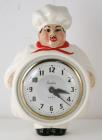 Credits:
Credits:The Canadian Clock Museum
3
Green roof example, Snider Clock Corporation's china-cased birdhouse wall clock (windup movement).early to mid 1950s
The Canadian Clock Museum, Deep River, Ontario
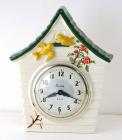 Credits:
Credits:The Canadian Clock Museum
4
Early starburst electric wall clock, glass over dial, no wood rays, Snider Clock Mfg Co.late 1950s early 1960s
The Canadian Clock Museum, Deep River, Ontario
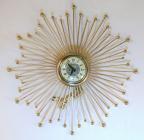 Credits:
Credits:The Canadian Clock Museum
5
A third early starburst electric wall clock, Snider Clock Mfg Co.late 1950s early 1960s
The Canadian Clock Museum, Deep River, Ontario
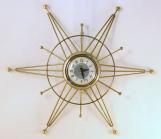 Credits:
Credits:The Canadian Clock Museum
6
A black and white version of the painted-wood "atomic" electric wall clock, Snider Clock Mfg Co.late 1950s early 1960s
The Canadian Clock Museum, Deep River, Ontario
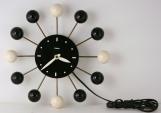 Credits:
Credits:The Canadian Clock Museum
7
Model 100 variation on the "atomic" electric wall clock, Snider Clock Mfg Co.late 1950s early 1960s
The Canadian Clock Museum, Deep River, Ontario
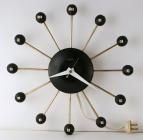 Credits:
Credits:The Canadian Clock Museum
8
Turquoise version of the Snider Spider electric wall clock, Snider Clock Mfg Co.late 1950s early 1960s
The Canadian Clock Museum, Deep River, Ontario
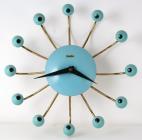 Credits:
Credits:The Canadian Clock Museum
9
Model 900 electric wall clock, Snider Clock Mfg Co.late 1950s early 1960s
The Canadian Clock Museum, Deep River, Ontario
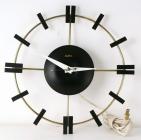 Credits:
Credits:The Canadian Clock Museum
10
White version of late 1950s electric wall clock, Snider Clock Mfg Co.late 1950s
The Canadian Clock Museum, Deep River, Ontario
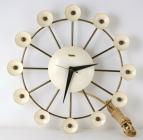 Credits:
Credits:The Canadian Clock Museum
11
Turquoise version "basket" desk/wall electric clock, Snider Clock Mfg Co.late 1950s early 1960s
The Canadian Clock Museum, Deep River, Ontario
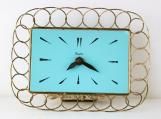 Credits:
Credits:The Canadian Clock Museum
12
Square electric "basket" wall clock, Snider Clock Mfg Co.late 1950s early 1960s
The Canadian Clock Museum, Deep River, Ontario
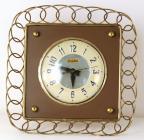 Credits:
Credits:The Canadian Clock Museum
13
"Basket" electric wall clock, large metal dial and hour-marker balls, Snider Clock Mfg Co.late 1950s early 1960s
The Canadian Clock Museum, Deep River, Ontario
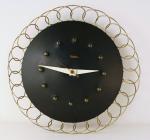 Credits:
Credits:The Canadian Clock Museum
14
Model 800 electric wall clock, Snider Clock Mfg Co.late 1950s
The Canadian Clock Museum, Deep River, Ontario
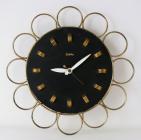 Credits:
Credits:The Canadian Clock Museum